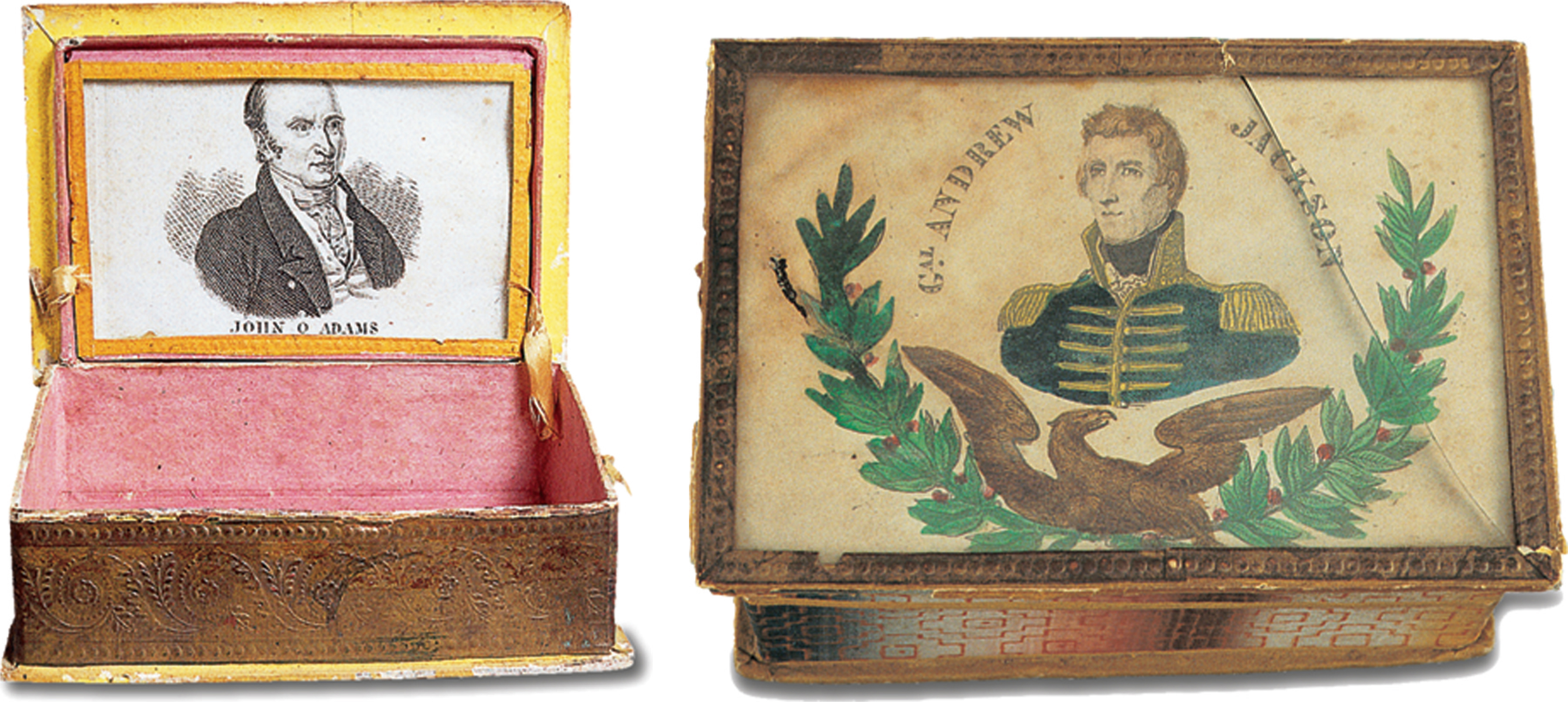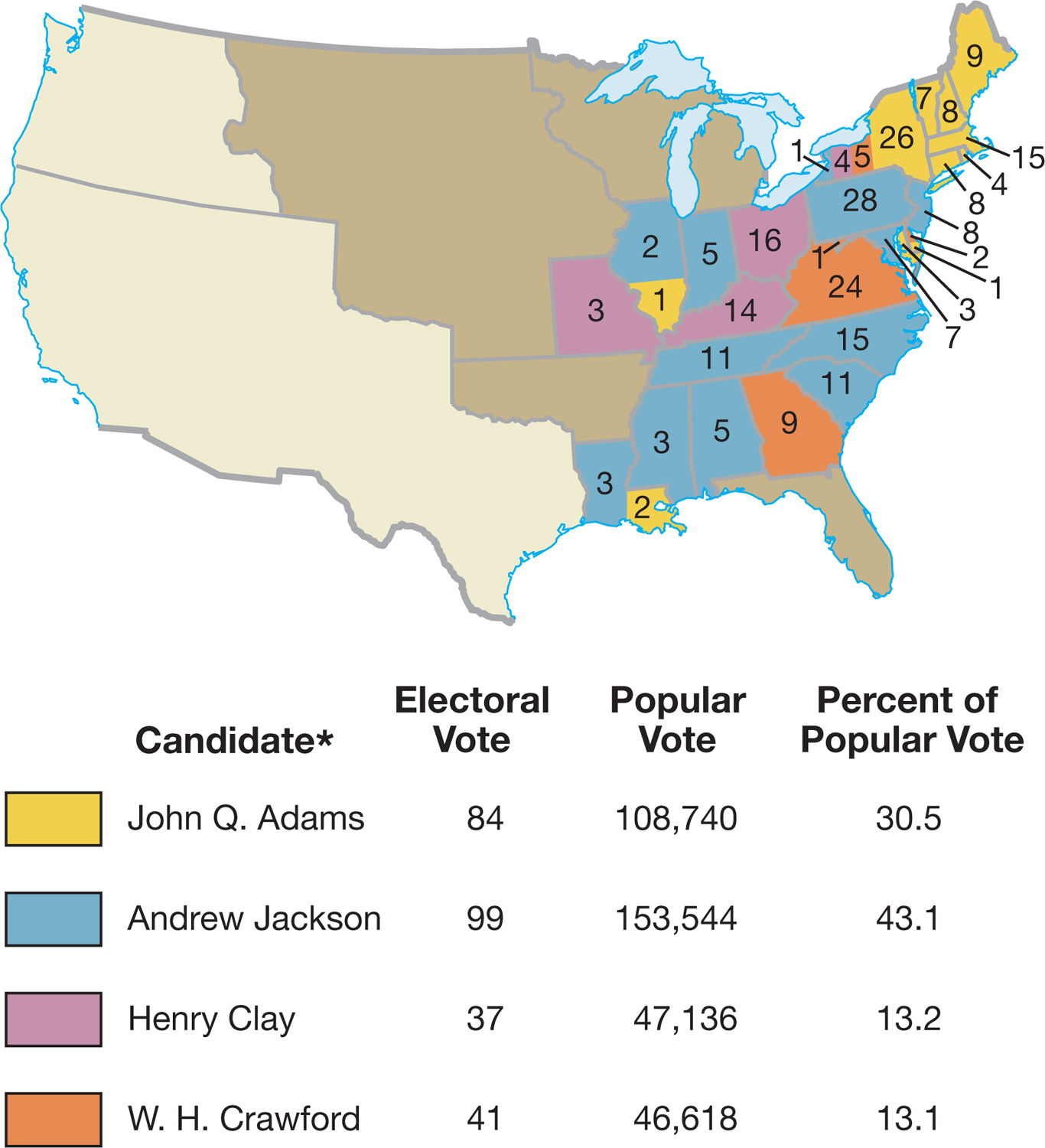The American Promise:
Printed Page 277
The American Promise Value
Edition: Printed Page 263
Chapter Chronology
The Election of 1824
Monroe’s nonpartisan administration was the last of its kind, a throwback to eighteenth-century ideals, as was Monroe, with his powdered wig and knee breeches. Monroe’s cabinet contained men of sharply different philosophies, all calling themselves Republicans. Secretary of State John Quincy Adams represented the urban Northeast; South Carolinian John C. Calhoun spoke for the planter aristocracy as secretary of war; and William H. Crawford of Georgia, secretary of the treasury, was a proponent of Jeffersonian states’ rights and limited federal power. Even before the end of Monroe’s first term, these men and others began to maneuver for the election of 1824.
Crucially helping them to maneuver were their wives, who accomplished some of the work of modern campaign managers by courting men—and women—of influence. Louisa Catherine Adams had a weekly party for guests numbering in the hundreds. The somber Adams lacked charm—“I am a man of reserved, cold, austere, and forbidding manners,” he once wrote—but his abundantly charming (and hardworking) wife made up for that. She attended to the etiquette of social calls, sometimes making two dozen in a morning, and counted sixty-eight members of Congress as her regular guests. This was smart politics, in case the House of Representatives wound up deciding the 1824 election—which it did.

Election Sewing or Trinket Boxes from 1824 Women could express support for a presidential candidate by purchasing a sewing box emblazoned with his face. The box to the left bears John Quincy Adams’s picture; the box top (not visible here) has a velvet pincushion printed with the slogan “Be Firm for Adams.” The competing box on the right features Andrew Jackson’s likeness under glass on top of the cover. © David J. & Janice L. Frent Collection/CORBIS.
John Quincy Adams (and Louisa Catherine) were ambitious for the presidency, but so were others. Candidate Henry Clay, Speaker of the House and negotiator of the Treaty of Ghent with Britain in 1814, promoted a new “American System,” a package of protective tariffs to encourage manufacturing and federal expenditures for internal improvements such as roads and canals. Treasurer William Crawford was a favorite of Republicans from Virginia and New York, even after he suffered an incapacitating stroke in mid-1824. Calhoun was another serious contender, having served in Congress and in several cabinets. A southern planter, he attracted northern support for his backing of internal improvements and protective tariffs.
The final candidate was an outsider and a latecomer: General Andrew Jackson of Ten-nessee. Jackson had far less national political experience than the others, but he enjoyed great celebrity from his military career. In 1824, on the anniversary of the battle of New Orleans, the Adamses threw a spectacular ball in his honor, hoping that some of Jackson’s charisma would rub off on Adams, who was not yet thinking of Jackson as a rival for office. Not long after, Jackson’s supporters put his name forward for the presidency, and voters in the West and South reacted with enthusiasm, Adams was dismayed, and Calhoun dropped out of the race and shifted his attention to winning the vice presidency.
Along with democratizing the vote, eighteen states (out of the full twenty-four) had put the power to choose members of the electoral college directly in the hands of voters, making the 1824 election the first one to have a popular vote tally for the presidency. Jackson proved by far to be the most popular candidate, winning 153,544 votes. Adams was second with 108,740, Clay won 47,136 votes, and the debilitated Crawford garnered 46,618. This was not a large turnout, probably amounting to just over a quarter of adult white males. Nevertheless, the election of 1824 marked a new departure in choosing presidents. Partisanship energized the electorate; apathy and a low voter turnout would not recur until the twentieth century.

MAP 10.5 The Election of 1824
In the electoral college, Jackson received 99 votes, Adams 84, Crawford 41, and Clay 37 (Map 10.5). Jackson lacked a majority, so the House of Representatives stepped in for the second time in U.S. history. Each congressional delegation had one vote; according to the Constitution’s Twelfth Amendment, passed in 1804, only the top three candidates joined the runoff. Thus Henry Clay was out of the race and in a position to bestow his support on another candidate.
Jackson’s supporters later characterized the election of 1824 as the “corrupt bargain.” Clay backed Adams, and Adams won by one vote in the House in February 1825. Clay’s support made sense on several levels. Despite strong mutual dislike, he and Adams agreed on issues such as federal support to build roads and canals. Moreover, Clay was uneasy with Jackson’s volatile temperament and unstated political views and with Crawford’s diminished capacity. What made Clay’s decision look “corrupt” was that immediately after the election, Adams offered to appoint Clay secretary of state—and Clay accepted.
In fact, there probably was no concrete bargain; Adams’s subsequent cabinet appointments demonstrated his lack of political astuteness. But Andrew Jackson felt that the election had been stolen from him, and he wrote bitterly that “the Judas of the West [Clay] has closed the contract and will receive the thirty pieces of silver.”

